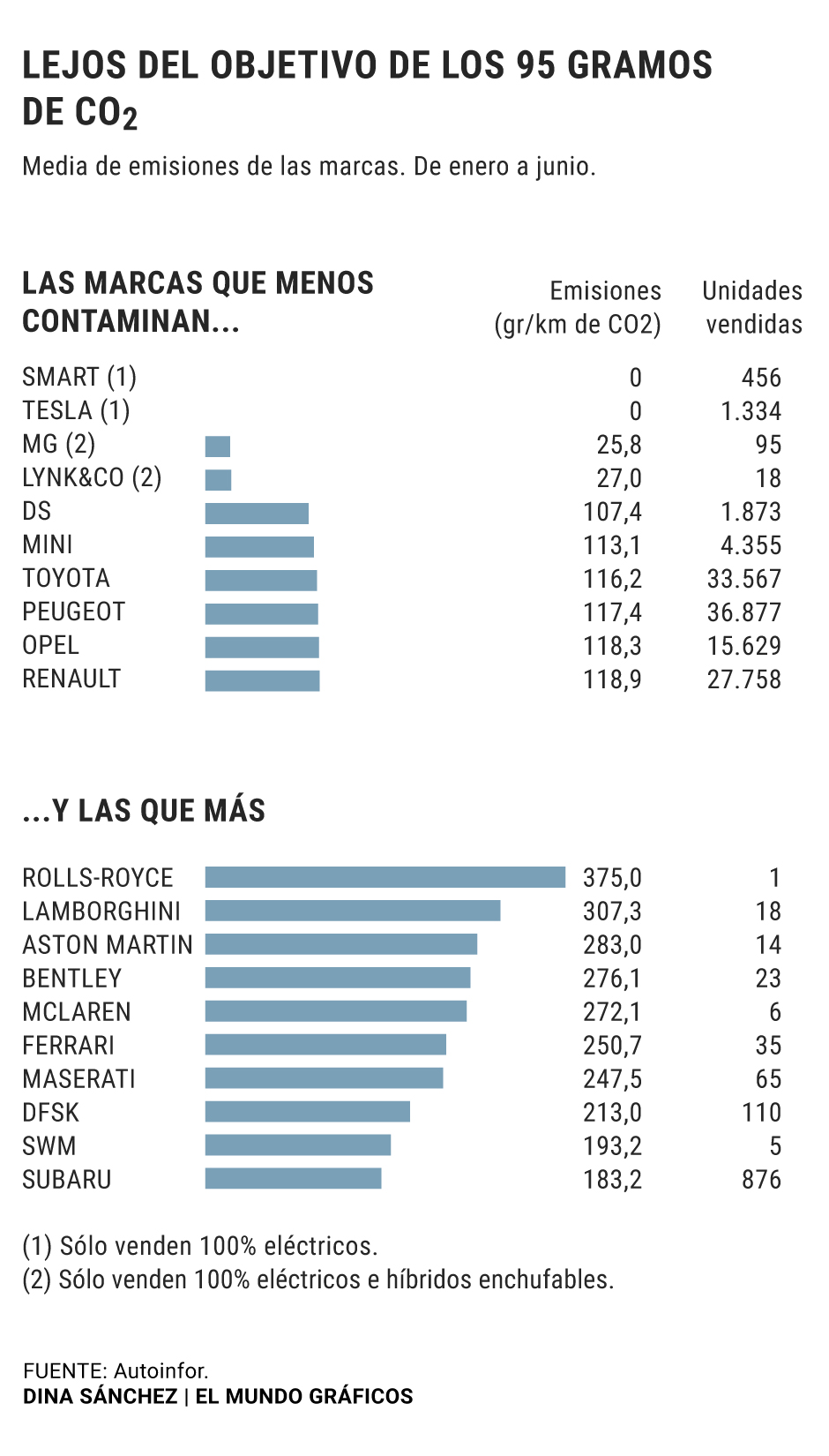Emissions The Supreme Court declares Volkswagen responsible in Spain for the dieselgate
Mercedes-Benz emissions will be electric only where required by law
New cars sold in Spain during the first half of the year emit, on average,
126.3 g / km of CO2
. We are making good progress, since we started from an average of 127.2 grams in January and have gradually decreased until the end of
June with 123.8 grams / km of CO2
. It should be taken into account that the new WLTP measurement system, which came into force this year, has raised the figures declared by manufacturers with the previous system by around 20%.
Even so, the Spanish average of emissions is very
far from the 95 g / km of CO2 that the EU sets as a limit per manufacturer
.
If the brands do not compensate the excess of countries like Spain, they will have to face millionaire sanctions: 95 euros per gram of surplus and car sold.
Seat computed 225 million euros in its 2020 balance sheet for this concept.
As can be seen in the graph, the leading brands in lower CO2 emissions are Tesla and Smart, the only ones, today, that sell only 100% electric models.
The Chinese MG and Link & Co offer plug-in hybrid variants.
The first brand in the ranking of those that sell combustion models is
DS
.
Its director in Spain, Borja Sekulits, said in recent statements to the press that he hopes to reduce those
107 g / km of CO2
with more sales of electrified products by the end of the year.
Thus, all manufacturers propose in their roadmap for the second half of the year to encourage sales of their electric and plug-in hybrids to avoid the penalties established by Brussels.
In addition, this year
the sale of a low-emission vehicle counts as 1.67 total sales of the manufacturer in 2021
.
Next year they will count as 1.33 sales, while in 2023 all models in the range will count the same.
Ranking
According to data from the consulting firm AutoInfor, the ten brands that have sold the most models in the Spanish market in the first half are far from those 95 g / km of CO2:
Seat, 124.8;
Peugeot, 117.4;
Volkswagen, 132.6;
Toyota, 116.2;
Renault, 118.9;
Kia, 122.7;
Citroën, 121.3;
Hyundai, 126.6;
Audi, 137.7;
and Mercedes, 132.5.
Without exemptions,
Seat
, which has sold 41,990 cars and exceeds the legal limit by 29.8 grams, would now have a gross penalty of 118.8 million.
Now, brands have a second way of balancing their emissions figures, since the calculation is grouped not only for all European countries, but also by manufacturer.
In the example above,
Seat could compensate with low-emission vehicles and sum the data from Cupra.
In turn, Seat and Cupra are part of the Volkswagen Group, which decides to which of its brands it allocates more or less CO2: since the fine is applied per gram of surplus and car sold, it is logical for manufacturers to ensure that their brands best-seller declare that they comply with the limit required by the EU.
In this context, the brands continue their
offensive of electric vehicles to the market
.
At the next Munich Motor Show, Mercedes-Benz will unveil the EQE, the battery-powered version of the E-Class;
BMW will have the hydrogen iX5;
Skoda the Enyaq coupe, Hyundai, the Ioniq 5, Kia the EV6, and Mini its Vision Urbanaut.
We will also see the Polestar 2, the Porsche Taycan Cross Turismo, the Renault eMégane, a smart SUV prototype and the Volkswagen ID.5.
Hybrids
In Spain, deliveries of plug-in hybrids will rise between now and the end of the year.
For two reasons: the lack of charging infrastructure penalizes the purchase of a 100% electric vehicle by individuals.
In addition, plug-in hybrids have been taxed in countries like the Netherlands because their users did not use the electric mode, so now brands try to place them in countries like ours.
So far this year,
19,125 plug-in hybrids
have been sold
in Spain, representing a share of 4.19%, and 9,255 electric ones, accounting for 2.06% of the market
.
Still far from the 10% green quota expected by the sector by the end of the year.
The rest of the electrified vehicles that the brands advertise (conventional hybrid or light hybrid -mild hybrid-) count in sales the same as a gasoline or diesel one.
While conventional hybrids emit less than what is required by the EU - for example,
the Toyota Yaris approves 87 grams -
;
the mild hybrids, no.
For example,
a Renault Arkana micro hybrid emits 132 grams of CO2
.
These vehicles do have the appeal of the ECO label.
According to the criteria of The Trust Project
Know more
Motor
Environment
Electric cars
Mobility Electric Stations and Hydrogen Stations: Why is Spain at the bottom of Europe?
AutomotiveGestamp calls for a 'sensible transition': "An attempt has been made to counterpose the industrial sector as something 'dirty' compared to green"
Strategy Mercedes-Benz will be electric in some markets by 2030
See links of interest
Last News
Work calendar
Home THE WORLD TODAY
Master Investigation Journalism
Canada - Spain, live
Spain - Argentina, live
Spain - Slovenia, live
F1: Hungarian GP, live

